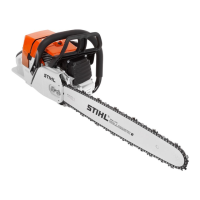22
English / USA
MS 440, MS 440 W, MS 440 C
B = Felling cut
Conventional and open-face technique:
: Begin 1 to 2 inches (2,5 to 5 cm)
higher than centre of felling notch
: Cut horizontally towards the felling
notch
: Leave approx.1/10 of diameter
uncut. This is the hinge
: Do not cut through the hinge - you
could lose control of the direction of
the fall
Drive wedges into the felling cut where
necessary to control the fall.
!Warning!
If the tip of the bar contacts a wedge, it
may cause kickback. Wedges should be
of wood or plastic - never steel, which
can damage the chain.
C = Hinge
: Helps control the falling tree
: Do not cut through the hinge -you
could lose control of the direction of
the fall
!Warning!
In order to reduce the risk of personal
injury, never stand directly behind the
tree when it is about to fall, since part of
the trunk may split and come back
towards the operator (barber-chairing),
or the tree may jump backwards off the
stump. Always keep to the side of the
falling tree. When the tree starts to fall,
withdraw the bar, shut off the engine and
walk away on the preplanned escape
path. Watch out for falling limbs.
!Warning!
Be extremely careful with partially fallen
trees which are poorly supported. When
the tree hangs or for some other reason
does not fall completely, set the saw
aside and pull the tree down with a cable
winch, block and tackle or tractor. If you
try to cut it down with your saw, you may
be injured.
Felling cut for small diameter trees:
simple fan cut
Engage the bumper spikes of the
chainsaw directly behind the location of
the intended hinge and pivot the saw
around this point only as far as the
hinge. The bumper spike rolls against
the trunk.
001BA044 KN
B
B
001BA045 KN
C
C
001BA046 KN

